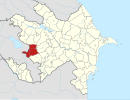Chldran
Chldran / Childiran
Չլդրան / Çıldıran | |
|---|---|
 | |
| Coordinates: 40°06′13″N 46°38′44″E / 40.10361°N 46.64556°E | |
| Country | |
| • District | Kalbajar |
| Population (2015)[1] | |
| • Total | 528 |
| Time zone | UTC+4 (AZT) |
Chldran (Armenian: Չլդրան) or Childiran (Azerbaijani: Çıldıran) is a village in the Kalbajar District of Azerbaijan, in the disputed region of Nagorno-Karabakh.
The village is made up of six neighborhoods; Vrtskaler, Kyurkoreg, Perin Gomer, Khor Dzor, Pokr Chldran and Ghalunts Tagh.[2]
Etymology
According to Arsène Saparov, the name of the village is of Persian origin.[3] According to Sergey Melkumyan, the name originated from the name of the ethnically Armenian Chali brothers, due to their patriotism.[2]
History
The modern village of Chldran was founded in 1905, by settlers from Arajadzor.[2] During the Soviet period, the village was a part of the Mardakert District of the Nagorno-Karabakh Autonomous Oblast.
Historical heritage sites
Historical heritage sites in and around the village include the 16th/17th-century church of Karmir Yeghtsi (Armenian: Կարմիր Եղցի) 300 m to the north, the partially ruined Nahatak Church 2.2 km to the northeast, with an adjacent cemetery with khachkars, and the religious site of Tatver 3.5 km to the northeast.[4]
Economy and culture
The population is mainly engaged in agriculture and animal husbandry. As of 2015, the village has a municipal building, a secondary school, nine shops, and a medical centre.[1] The village school named after Tigran Izmirlian was destroyed in the First Nagorno-Karabakh War. It was rebuilt in 2002, and a renovation and expansion project, jointly sponsored by the Artsakh government, Armenia Fund and the Izmirlian Foundation, commenced in 2020.[5]
Demographics
The village had an ethnic Armenian-majority population, with 467 inhabitants in 2005,[6] and 528 inhabitants in 2015.[1] According to one study, the village had an Azerbaijani-majority population prior to their exodus during the First Nagorno-Karabakh War.[7][better source needed] According to Melkumyan's book, the village has been solely inhabited by Armenians.[2] In 1970 the village had 87 houses and 366 inhabitants, and by 1987 there were 173 houses and 476 inhabitants.[2]
References
- ^ a b c Hakob Ghahramanyan. "Directory of socio-economic characteristics of NKR administrative-territorial units (2015)".
- ^ a b c d e Մելքումյան, Սերգեյ (1990). Լերնային Ղարաբաղ. p. 303.
- ^ Arsène Saparov (2017-09-01). "Contested spaces: the use of place-names and symbolic landscape in the politics of identity and legitimacy in Azerbaijan". Central Asian Survey. 36 (4): 534–554. doi:10.1080/02634937.2017.1350139.
- ^ Kiesling, Brady; Kojian, Raffi (2019). Rediscovering Armenia: An in-depth inventory of villages and monuments in Armenia and Artsakh (3rd ed.). Armeniapedia Publishing.
- ^ "Izmirlian Foundation". am.izmirlianfoundation.am. Retrieved 2021-12-09.
- ^ "The Results of the 2005 Census of the Nagorno-Karabakh Republic" (PDF). National Statistic Service of the Republic of Artsakh.
- ^ Андрей Зубов. "Андрей Зубов. Карабах: Мир и Война". drugoivzgliad.com.




